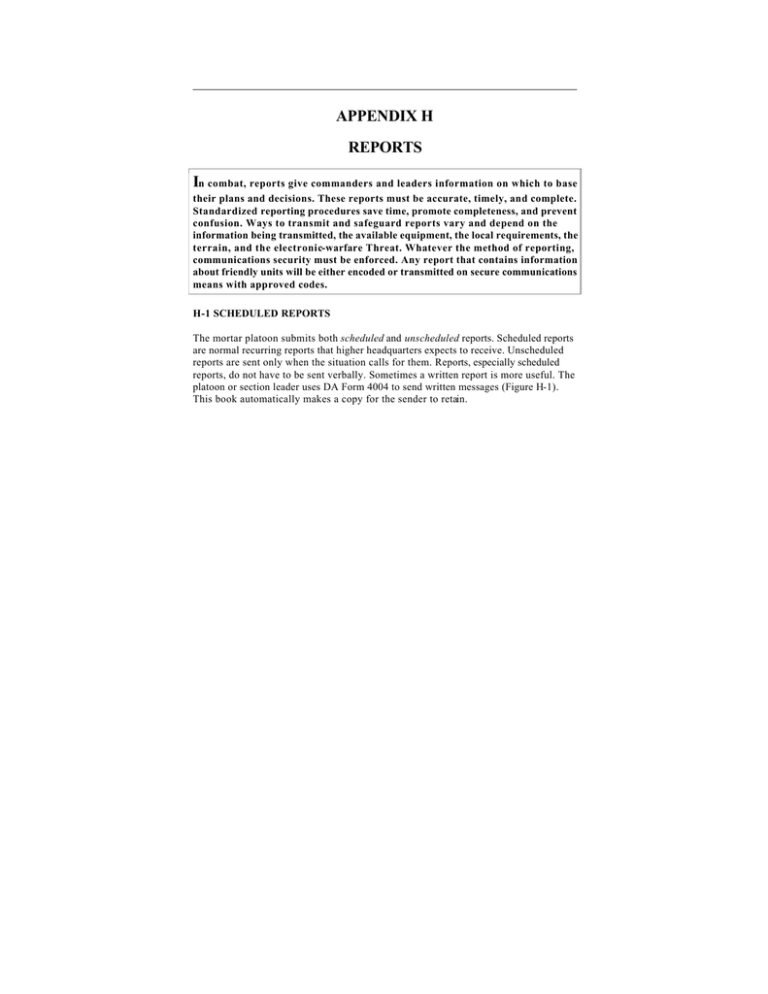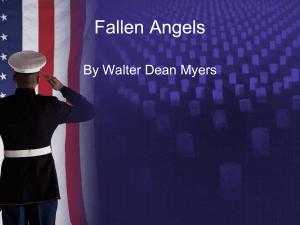APPENDIX H REPORTS I
advertisement

APPENDIX H REPORTS In combat, reports give commanders and leaders information on which to base their plans and decisions. These reports must be accurate, timely, and complete. Standardized reporting procedures save time, promote completeness, and prevent confusion. Ways to transmit and safeguard reports vary and depend on the information being transmitted, the available equipment, the local requirements, the terrain, and the electronic-warfare Threat. Whatever the method of reporting, communications security must be enforced. Any report that contains information about friendly units will be either encoded or transmitted on secure communications means with approved codes. H-1 SCHEDULED REPORTS The mortar platoon submits both scheduled and unscheduled reports. Scheduled reports are normal recurring reports that higher headquarters expects to receive. Unscheduled reports are sent only when the situation calls for them. Reports, especially scheduled reports, do not have to be sent verbally. Sometimes a written report is more useful. The platoon or section leader uses DA Form 4004 to send written messages (Figure H-1). This book automatically makes a copy for the sender to retain. H-2. FIRING LOCATION REPORTS The mortar platoon leader sends a firing location report to the TOC at least once every 24 hours or each time the platoon moves. The battalion or troop SOP may require this report more often. The higher headquarters establishes a set format for this report. The firing location report includes the following: a. Whether or not the platoon or section is laid and ready to fire. b. Grid location of platoon or sections. c. Mounting azimuth. d. Number of mortars able to fire. e. Maximum range available from this firing location. f. Priority of mortar fires. g. Any limitations on fire from this location. H-3. UNIT STATUS REPORTS The battalion SOP normally specifies the personnel status and logistics status feeder reports required from the mortar platoon, and the format for these reports. It also specifies the reporting times and the period to be covered in each report (Figures H-2 and H-3). H-4. AMMUNITION STATUS REPORT The mortar platoon leader sends specific ammunition status reports to the operations officer and FSO. The operations officer and FSO use these reports to keep abreast of the mortar platoon's changing situation and to balance the mortar platoon's fire against those of the supporting artillery. If a CSR is in effect, the mortar platoon leader sends these type reports more often. The battalion SOP establishes the format and period for the ammunition status report. H-5. UNSCHEDULED REPORTS This paragraph complies with STANAGs 2022 and 2020. Unscheduled reports are normally of a more urgent nature than scheduled reports. They are sent when the situation changes significantly or when an event occurs that calls for the report. Examples of unscheduled reports are SPOTREP, SITREP, SHELREP or MORTREP, and MIJIREP. a. The platoon uses a SPOTREP to report enemy information. The SPOTREP format is set by a higher command, or the platoon submits a SPOTREP that conforms to STANAG 2022 and uses the memory aid SALUTE (Figure H-4). b. The platoon uses a SITREP to report the platoon's tactical situation for a specific period. The format and period for reporting is specified by the battalion SOP (Figure H5) and conforms with STANAG 2020. c. An ammunition incident report has no set format. The mortar platoon leader submits one when an incident occurs that involves mortar ammunition. Incidents such as misfires, hangfires, duds, premature detonation, fuze malfunctions, or problems with mortar propellent charges are all reported to the operations officer and FSO. If the incident is serious, firing that lot of ammunition is suspended if the combat situation permits (Figure H-6). d. The mortar platoon prepares and submits a SHELREP or MORTREP each time it receives incoming artillery or mortar rounds. This report is a vital step in the division's counterfire program. The platoon leader conducts crater analysis whenever he can to furnish further information for the SHELREP (Figure H-7). e. The mortar platoon should submit a MIJIREP whenever an incident occurs. The higher headquarters establishes the format for a MIJIREP. When the mortar leader observes the enemy using any directed-energy weapons, such as lasers, he should submit a MIJIREP.

